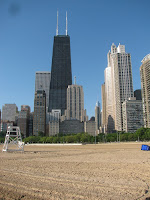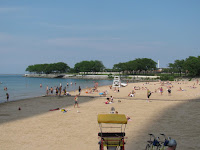



 Once upon a time, sand worked its way southward down the west side of Lake Michigan, building out into the lake in a series of spits at the mouth of the Chicago River. But one thing led to another and the beaches were gradually (or not so gradually) left behind as the city moved into the lake.
Once upon a time, sand worked its way southward down the west side of Lake Michigan, building out into the lake in a series of spits at the mouth of the Chicago River. But one thing led to another and the beaches were gradually (or not so gradually) left behind as the city moved into the lake.
Then David Burnham came along and saw the potential for a hugely public, albeit hugely artificial, shoreline. Like many other Great Lakes cities, lake fill was an obvious solution, but in Chicago they seemed to have done it better and bigger than others. The result is miles of public park along the lake front, trimmed with stepped concrete walls, artificial beaches, marinas, and park space. The wind and wave regime hasn't changed appreciably since the city arrived, so sand placed along the shore would move southward rapidly were it not configured with jetties and landfill into a series of north facing pocket beaches. Some are isolated, some segmented by groins.
Oak Street Beach, at the north end of Michigan Avenue, fits into a corner in the lake fill - kept in place by Lake Shore Drive as it curves east around the northern part of downtown. The straight seawall north of Oak Street precludes a beach, so it sort of pretends to be one. Despite what could easily have been viewed as ugly, I thought it was actually pretty neat and it certainly got its share of use, at least later in the day (these shots are mainly early in the morning). I suppose it was underwater in the mid-1980s when lake levels were high.





The northern shore of lake Erie (Google Maps) is punctuated by three elegant landforms. The location of each may be determined by glacial features like moraines, but the shape of each is all about wind and waves and moving sediment. There are good bathymetric maps and geologic explanations of Lake Erie at NOAA's NGDC.
Long Point is a spit, neither a simple nor a small one.
Point aux Pins (Rondeau Provincial Park) is an arcuate promontory that might be categorized as a recurved or cuspate spit. Its southeastern shore is composed of a beautiful series of accreted beach ridges, while its western shore is somewhat more tenuous. There is a big offset in the shoreline at the jetties at Erieau and the map on the wall at the Eau Buoy Cafe showed that in 1868 the natural opening was much larger and located pretty much where the town is today.
Point Pelee, where all of the these photos are from, is a large cuspate foreland, tapering to a slender point. It has lost ground, or at least changed shape, over time, making the riprap on the west side of the tip seem both unfortunate and sort of futile. The sinuous tip vanished southward under the waves, tempting me to wade out farther, but the biting flies argued against it.
Point Pelee is the southernmost point in mainland Canada. The country's true southernmost point is a very similar looking spit at the southern tip of Pelee Island, maybe 25 km south of here.




This is a more geographically general post than most, since my goal was simply to capture several shots taken as we traveled between the Cape Rondeau area and the western end of the lake. This shoreline consists mainly of bluffs, many of clay or silt, but there are also low beaches, including the large barriers that have formed at Point aux Pins and Point Pelee.
The geography of this shoreline appears to be controlled by larger glacial features and sediment variability, subsequently reshaped by Holocene coastal processes. Humans have left their mark, too, with jetties, lots of groins, and a mish mash of armoring, at least locally. Most of the shoreline development is on the low beaches, probably because the bluffs are eroding quickly enough to discourage building and because the demand for Lake Erie view property isn't the same as on Puget Sound.
The timber groins are at Erie Beach?, just west of Erieau (Aerial).
The bluffs are at Point Alma (Aerial).
The sheetpile groins are on the west side of Point Pelee, near Seacliffe. (Aerial)





A long drive across North America ended today with two beaches on its far right edge. The coast of Maine, at least of southern Maine, has a rocky framework with beaches filling in the interstices. In some places, like Ogunquit and Old Orchard, the beaches are long strands and dominate the landscape, while on the midcoast, like at Reid and Popham, the rocky skeleton stands out and the beaches are small and isolated.
Our first view of the Atlantic was through an Independence Day weekend crowd of kites and balloons and sunbathers. The east end of Beach Street crosses to the southern tip of the spit and people covered the sand on both the ocean side and along the river on the inside. Farther south, across the small river, are the rocky headlands that extend south toward Cape Neddick.
The waves were gentle and the beach was flat, with a broad low trough (runnel?) separating the upper beach from an equally subdued bar at the water's edge.




















 Silver Beach in St. Joseph was crowded at lunchtime on Saturday when we passed through (more pictures at hshipman).
Silver Beach in St. Joseph was crowded at lunchtime on Saturday when we passed through (more pictures at hshipman).





































